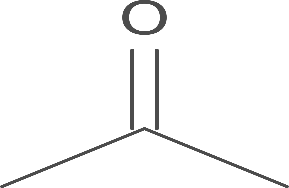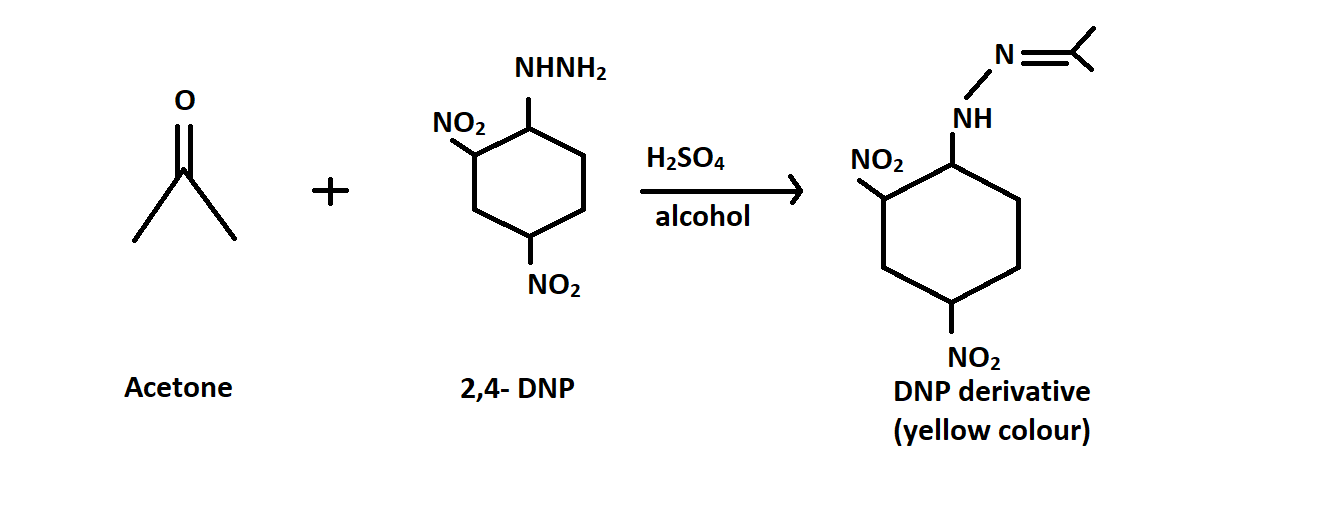
Acetone gives positive test with:
A. Fehling's solution
B. Schiff's solution
C.
D. all of the above
Answer
498.3k+ views
Hint:Before solving the question, the first thing to keep in mind is that acetones belong to the ketone functional group. Ketones do not have the hydrogen (attached to carbon – oxygen double bond) which is present in aldehydes.
Complete step by step answer:
-Fehling’s solution is a reagent which is used to differentiate between reducing and non-reducing sugars, to determine whether a carbonyl compound is an aldehyde or ketone.
-Schiff’s solution is a reagent which is used to detect presence of aldehydes.
-
We know that acetone belong to the ketone functional group category having the following structure:

-Acetones in general do not respond to Fehling’s test , because they do not have the hydrogen (attached to carbon – oxygen double bond which is present in aldehydes) which will undergo oxidation, hence it is difficult to oxidise them with this solution. Ketones are very less reactive towards oxidation.
-Similarly Schiff’s reagents do not bring about oxidation in ketones. Thus option A and B are incorrect.
-Acetone, however reacts with

Therefore Option C is correct.
Additional Information:
Fehling’s solution is actually a deep blue alkaline solution prepared by combining two different solutions. First is Fehling’s A which is copper (II) sulphate solution, deep blue in colour and the other is Fehling’s B which is a solution of aqueous sodium potassium tartrate (also known by the name Rochelle salt) which is colourless. These two are mixed and made strongly alkaline by adding potassium hydroxide (
Schiff’s solution is Fuchsine or rosaniline which is a magenta coloured dye having the chemical formula
Note:
We need to be careful with Fehling’s test as some
Complete step by step answer:
-Fehling’s solution is a reagent which is used to differentiate between reducing and non-reducing sugars, to determine whether a carbonyl compound is an aldehyde or ketone.
-Schiff’s solution is a reagent which is used to detect presence of aldehydes.
-
We know that acetone belong to the ketone functional group category having the following structure:

-Acetones in general do not respond to Fehling’s test , because they do not have the hydrogen (attached to carbon – oxygen double bond which is present in aldehydes) which will undergo oxidation, hence it is difficult to oxidise them with this solution. Ketones are very less reactive towards oxidation.
-Similarly Schiff’s reagents do not bring about oxidation in ketones. Thus option A and B are incorrect.
-Acetone, however reacts with

Therefore Option C is correct.
Additional Information:
Fehling’s solution is actually a deep blue alkaline solution prepared by combining two different solutions. First is Fehling’s A which is copper (II) sulphate solution, deep blue in colour and the other is Fehling’s B which is a solution of aqueous sodium potassium tartrate (also known by the name Rochelle salt) which is colourless. These two are mixed and made strongly alkaline by adding potassium hydroxide (
Schiff’s solution is Fuchsine or rosaniline which is a magenta coloured dye having the chemical formula
Note:
We need to be careful with Fehling’s test as some
Latest Vedantu courses for you
Grade 10 | MAHARASHTRABOARD | SCHOOL | English
Vedantu 10 Maharashtra Pro Lite (2025-26)
School Full course for MAHARASHTRABOARD students
₹33,300 per year
Recently Updated Pages
Master Class 12 Economics: Engaging Questions & Answers for Success

Master Class 12 Maths: Engaging Questions & Answers for Success

Master Class 12 Biology: Engaging Questions & Answers for Success

Master Class 12 Physics: Engaging Questions & Answers for Success

Master Class 12 Business Studies: Engaging Questions & Answers for Success

Master Class 12 English: Engaging Questions & Answers for Success

Trending doubts
Which are the Top 10 Largest Countries of the World?

a Tabulate the differences in the characteristics of class 12 chemistry CBSE

Why is the cell called the structural and functional class 12 biology CBSE

Differentiate between homogeneous and heterogeneous class 12 chemistry CBSE

Derive an expression for electric potential at point class 12 physics CBSE

What are the major means of transport Explain each class 12 social science CBSE




